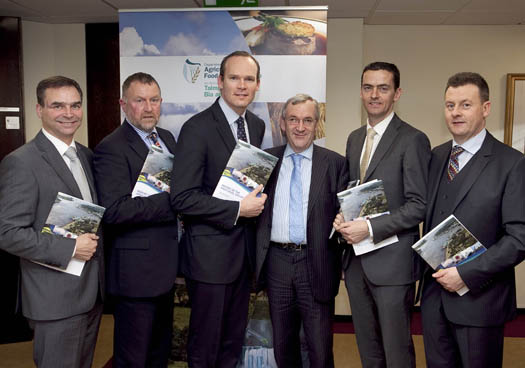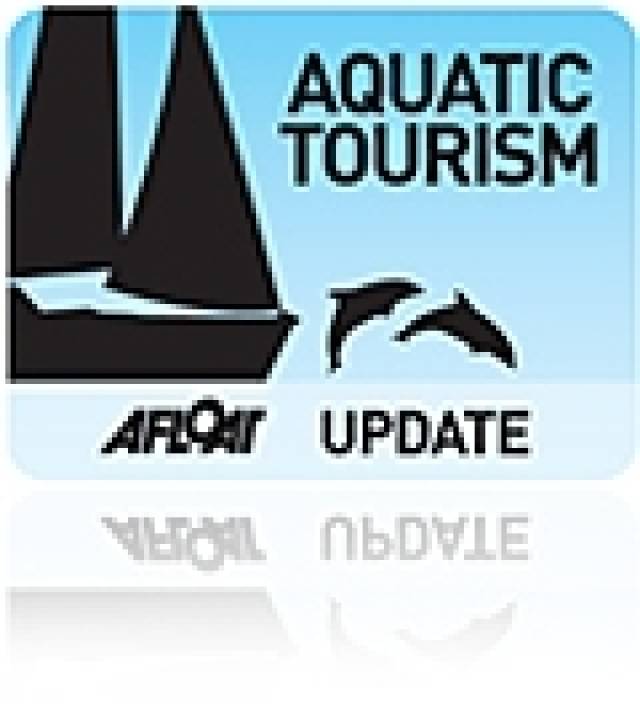#JOBS – 250 jobs could be created over a three year period across five key maritime areas in Killybegs according to a report launched by the Minister for Agriculture, Food and the Marine, Simon Coveney TD,
Minister Coveney set up the group on the 3rd June this year following the Economic Report for the European Commission, which assessed the status, development and potential diversification of Killybegs as a fisheries dependent community. The Group comprising of representatives from the Irish seafood sector, tourism, education, enterprise and the Department of Agriculture, Food and the Marine were tasked to identify potential jobs across key areas including seafood, ancillary services, offshore supports, tourism and marine leisure and green economy/renewable energy.

Minister for Agriculture, Food and the Marine, Simon Coveney with Sean O'Donoghue, Chairman, Chief Executive, Killybegs Fishermen's Organisation Ltd, Cecil Beamish, Assistant Secretary, Department of Agriculture, Food and the Marine, Seamus Neely, County Manager, Donegal County Council, Jason Whooley, Chief Executive, Bord Iascaigh Mhara (BIM), Paul Hannigan, President, Letterkenny Institute of Education, Jim Parkinson, Representing Offshore and Ancillary Services, Niall O'Gorman, Representing Donegal Fish Merchants Association and Conor Fahy, Regional Director, Enterprise Ireland at the launch of a report on Job Creation in the Killybegs Region.
Minister Coveney commented at the launch; "I set ambitious targets for the group and I am very pleased to see that the group has not only clearly outlined how 250 jobs can be achieved but has also identified new areas where additional jobs can be created into the future. The importance of the seafood sector to Killybegs region cannot be overstated as it is responsible for 68% of the workforce. The Group has identified that through greater diversification and adding value to our existing resources, 130 jobs will be delivered in this sector. The Group are to be commended for working together to complete this task in the allocated time and I am looking forward to seeing the actions from the report completed and the benefits that they will bring to the people of Killybegs".
The report outlines 250 jobs to be created over a three year period across five key areas. In total, 130 potential jobs were identified within the seafood sector. The expected increased access to raw materials such as blue whiting and boarfish present the most significant opportunities, along with a concerted focus on value adding opportunities. Within the ancillary services, 24 jobs were identified if collaborative opportunities between various companies can be enhanced and their abilities promoted. The offshore sector could generate 20 jobs, however competitive service provision and appropriate skill resources are deemed fundamental to achieve this. Approaching 50 jobs were identified within the tourism/marine leisure area if a co-ordinated marketing strategy is developed, whilst the green economy and renewable energy area offers the potential to create up to 40 jobs.
The Minister added "This pilot approach of co-ordinated developmentally focused activity which is concentrated on natural resources has delivered results that will drive economic development and job creation in the Killybegs region. An example of this is the partnership between BIM and LYIT to address seafood value added activities. As a direct result of this jobs initiative, the College of Catering in Killybegs will become a focus for industry activity beginning with a workshop on new product development for crab suppliers is already planned for the 30th November".
Members of the High Level Group are:
Sean O'Donoghue, Chairman, Chief Executive, Killybegs Fishermen's Organisation Ltd
Cecil Beamish, Assistant Secretary, Department of Agriculture, Food and Marine
Seamus Neely, County Manager, Donegal County Council
Jason Whooley, Chief Executive, Bord Iascaigh Mhara (BIM)
Paul Hannigan, President, Letterkenny Institute of Education
Jim Parkinson, Representing Offshore and Ancillary Services
Niall O'Gorman, Representing Donegal Fish Merchants Association
Conor Fahy, Regional Director, Enterprise Ireland





























































